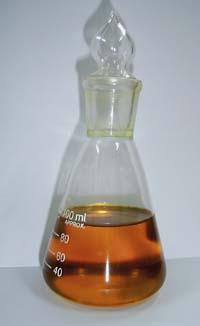The strength of vegetable oils, this time?
2007/02/01 Etxebeste Aduriz, Egoitz - Elhuyar Zientzia Iturria: Elhuyar aldizkaria

According to a European Union directive, in 2010 biofuels should account for 5.75% of all fuels. By 2005, 2% had to be biofuel, and with the exception of Sweden the other territories did not reach the target. In Spain, for example, this figure was 0.45%.
However, biofuels are taking a big boost. More and more biofuel plants are being created and more and more farmers are planting seeds for biofuels. Acciona and Repsol-YPF, for example, plan to build 6 biofuel plants by 2010, one of them in Bilbao, with a total production of one million tons of biodiesel.
Biodiesel in the Basque Country has been produced since 2003 in the Alava company Bionor, as well as in the Acciona factory in Navarra. The first, based on used oils, has a production capacity of 30,000 m 3 of biodiesel per year, while the second uses crude oils, produced for this purpose, with an annual production capacity of 35,000 tons.
Vegetable oils as fuel
These two raw materials are the main ones used in the production of biodiesel, that is, raw and used vegetable oils. In the first case, oils can be extracted from seeds and fruits of various oleaginous plants, there are about 300 species. However, the most used are rapeseed, sunflower, soy and palm.
In the second case the oils used in the kitchen are collected. In principle, from these oils, the same quality as with crude oils in the final product was not achieved. However, thanks to numerous studies and innovations, a biodiesel of the same quality as raw oils has been produced with used oils.

In both cases, the main process for obtaining biodiesel from these oils is transesterification. That is, by using a light alcohol, triglycerides and fatty acids contained in oils become methyl esters, and in this process the glycerin side product is also generated. These methyl esters are biodiesel.
The main objective of biodiesel is transport. It can be used in different proportions, theoretically in any diesel engine, without any change in the engine. In engines previously used with common diesel there may be initial problems with filters. In fact, biodiesel has a greater dissolution capacity than diesel and cleans the deposits generated during its use. Therefore, once started to use biodiesel, after the first two obligations, it is recommended to change the filters.
The results obtained in the tests of public transport have been satisfactory in general. In the municipal company EMT of Madrid, for example, in 2004 tests were carried out with mixtures of 20%, 50% and 100% of biodiesel, without any significant problems were detected in the engines. The only indentation found, with a consumption between 4 and 6% higher. And being biodiesel a little more expensive than diesel, it has its importance. However, 220 buses are currently being used with a 20% mix.
Advantages and disadvantages
The advantages and disadvantages of biodiesel have been widely discussed in recent times, and although for some it is an almost perfect fuel that does not pollute, others also worry.

There are points that nobody doubts: it is biodegradable, it is not toxic and due to its lower risk of fire is safer. In addition, due to its high lubrication capacity, it protects the engine. On the other hand, it is more viscous than diesel and reduces the efficiency of the injection system, in addition to accelerating freezing at low temperatures. However, these last two problems can be solved with suitable additives or mixed with diesel.
Another problem may be biodiesel storage. It is not very stable and, if you want to keep it for a long time, special treatments are necessary if you do not want to change the properties of the fuel.
However, compared to petroleum fuels, perhaps the most important difference is renewable. Oil reserves are running out. Experts estimate that oil remains at about 40 years and biodiesel can be, in principle, an alternative to oil.
However, according to environmentalists, if transport follows the current trend, in the world there is not enough land to produce biofuels. According to a U.S. study, if all soybeans produced were destined for the production of biodiesel, only 6% of the necessary diesel oil would be obtained.
On agriculture, biofuels offer new opportunities and the European Commission considers that biofuel production can be important for the sustainable economic growth of many developing countries.

However, for some experts, the production of biofuels from agricultural raw materials is worrying, since in many cases they are the same as those necessary for food and there can be competition between both uses.
Cleaning in question
Another point discussed is the cleaning of biofuels. According to several studies, emissions of gases into the atmosphere due to the combustion of biodiesel are generally much lower than those of diesel. According to a Acciona study, for example, OS 2 emissions are reduced by 99%, 63% of unburned hydrocarbons and 22% of CO. In the case of NOx gases, emissions increase by 5%.
In the case of CO 2, many jobs talk about reductions close to 90%. However, keep in mind that these calculations take into account the entire cycle. In other words, CO 2 is also taken into account when absorbing plants used to make biodiesel. But burning biodiesel releases both CO 2 and diesel.
Biofuel advocates claim that biofuels serve to reduce CO 2 emissions and fight the greenhouse effect. This can happen if empty lands are used to produce raw materials. But if the plants were already growing, they would absorb carbon dioxide equally, manufacture or not biofuels. Of course, to obtain plant farmland for biofuels, in cases of deforestation.

Finally, biodiesel production is currently more expensive than diesel. And therefore, this activity needs to make tax aid profitable. Currently, biofuels have a special rate of 0 euros, which the Spanish Government undertakes to maintain until 2012.
Against oil derivatives, it is clear that it is a cleaner and more sustainable fuel. However, it does not seem to include all the necessary features to be the fuel of the future. In the opinion of many experts, it can be an appropriate fuel to partially replace fuel derived from oil in the short term, but in the future other fuels will be needed. Hydrogen and fuel cells are one of the most hopeful options.



Gai honi buruzko eduki gehiago
Elhuyarrek garatutako teknologia






